Rojas-Nunez, J., Baltazar, S. E., Gonzalez, R. I., Bringa, E. M., Allende, S., Kiwi, M., & Valencia, F. J. (2020). Polycrystalline Ni nanotubes under compression: a molecular dynamics study. Scientific Reports, 10(1), 21096. https://doi.org/10.1038/s41598-020-76276-y
Abstract: Mechanical properties of nanomaterials, such as nanowires and nanotubes, are an important feature for the design of novel electromechanical nano-architectures. Since grain boundary structures and surface modifications can be used as a route to modify nanostructured materials, it is of interest to understand how they affect material strength and plasticity. We report large-scale atomistic simulations to determine the mechanical response of nickel nanowires and nanotubes subject to uniaxial compression. Our results suggest that the incorporation of nanocrystalline structure allows completely flexible deformation, in sharp contrast with single crystals. While crystalline structures at high compression are dominated by dislocation pinning and the multiplication of highly localized shear regions, in nanocrystalline systems the dislocation distribution is significantly more homogeneous. Therefore, for large compressions (large strains) coiling instead of bulging is the dominant deformation mode. Additionally, it is observed that nanotubes with only 70% of the nanowire mass but of the same diameter, exhibit similar mechanical behavior up to 0.3 strain. Our results are useful for the design of new flexible and light-weight metamaterials, when highly deformable struts are required.
Rafael González
rafael.gonzalez@umayor.cl


